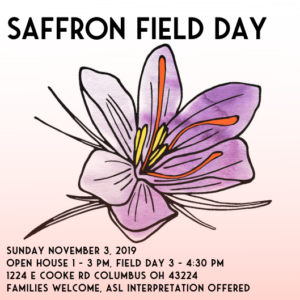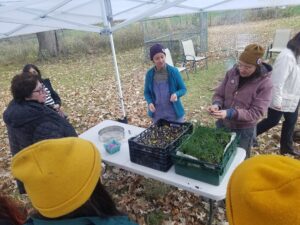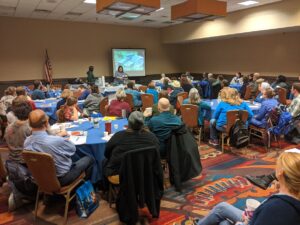Final report for FNC18-1146
Project Information
Foraged & Sown, a woman-owned, first-generation farm, grows annual herbs and vegetables in traditional rows, inter-cropped perennial herbs and berries in rows and orchard arrangement, and bench-grown seedlings and saffron in a small hoop house. The farm has been in operation since 2014 and through 2019 grew on 4 sites totaling 2 acres. The farm has been certified organic since 2017. Production is achieved with shared hand tools and a two-wheel walk-behind tractor.
In the first year of the Mad About Saffron project, we began exploring how to grow saffron in the Midwest through in-ground and hoop house production. We successfully harvested and processed the stigmas from 758 flowers collected in the field and containers. The three collaborating farmers visited a saffron operation in Ontario Canada in November 2018 to learn directly from another small producer. We sold saffron late in the farmers' market season to begin understanding the market potential of this product. Our 2018 packaging was a simple fold-over paper packet enclosing a sealed plastic sleeve with saffron inside. A info card told customers about the project and ways to cook with saffron.
The second year of the project began with more education by virtually attending the North American Center for Saffron Research & Development workshop in March. When the ground was finally dry in early summer, we harvested the field corms and noticed significant loss. We planted back the corms in containers, after concluding there was no practical, organic way to manage weeds and water in our field location. We added more purchased corms to additional containers to ensure a second year harvest, collecting 796 flowers in 2019.
We updated our saffron packaging with new graphics in 2019, sampled saffron rice at a farmers market demo, and created a recipe card for promotion and education. At the end of the 2019 season, we created and published a growing guide for both field and container production. We distributed the guide at an on-farm field day, during a conference presentation, and made it available on the Foraged & Sown website. The conference presentation discussed production methods, yields, customer interest, and a rough enterprise budget.
Key Findings (more findings and details provided in the research section of this report):
- Saffron container production is no more difficult in an organic system than a conventional system.
- Saffron field production is highly suceptible to weather and weed pressures.
- Saffron corms require an average of four seasons to produce daughter corms of a size to harvest from or sell.
- Cost of production is slightly more than potential income in the first years.
- More research is needed to understand and leverage consumer interest in saffron.
- Document and evaluate ecologically-sensitive weed management, harvesting, and storage practices for in- ground and bench-grown saffron over two growing seasons.
- Calculate a potential ‘profit per square foot’ estimate for saffron threads and bulbs grown on Midwestern farms.
- Share findings about best ecologically-sensitive growing practices through an online video, print fact sheet, conference presentation, and field day.
- Evaluate packaging and marketing methods for harvested saffron
- Share reasons to choose and use locally-grown saffron in a customer-targeted online video, print recipe card, and farmers’ market demo.
Cooperators
- (Researcher)
- (Researcher)
Research
To determine profitability and yield, we kept records of hours spent planting, cultivating, and harvesting saffron. We also counted flowers collected to extrapolate potential profit from the two different planting locations (hoop house and in-ground).
We tried a variety of methods to reach Midwestern customers including sampling, sharing recipe cards, and outreach activities described in another section of the report.
2018 yield of 18 crates and 120 row feet:
| date | # of flowers (hoop) | Minutes (Kate Hodges) | # flowers (field) | Minutes (Rachel Tayse) |
| 10/22 | 4 | 15 | ||
| 10/23 | 8 | 15 | ||
| 10/24 | 2 | 15 | ||
| 10/25 | 12 | 15 | ||
| 10/26 | ||||
| 10/27 | 20 | 30 | ||
| 10/28 | ||||
| 10/29 | 36 | 30 | ||
| 10/30 | 49 | 45 | ||
| 10/31 | ||||
| 11/1/2018 | 22 | |||
| 11/2/2018 | 101 | 6 | ||
| 11/3/2018 | 110 | 12 | ||
| 11/4 | 88 | 45 | 28 | (Kate) |
| 11/5 | 56 | 30 | 9 | (Kate) |
| 11/6 | 39 | 15 | 30 | |
| 11/7 | 21 | 30 | 12 | (Kate) |
| 11/8 | 17 | 15 | 8 | 15 |
| 11/9 | 2 | 15 | 16 | (Kate) |
| 11/10 | 0 | 0 | ||
| 11/11 | 0 | 5 | 15 | |
| 11/12 | 0 | |||
| 11/13 | 0 | |||
| 11/14 | 0 | |||
| 11/15 | 0 | |||
| 11/16 | 0 | 15 | 17 | (Kate) |
| 11/17 | 3 | 15 | 11 | (Kate) |
| 11/18 | 5 | 15 | ||
| 11/19 | ||||
| 11/20 | ||||
| 11/21 | ||||
| 11/22 | ||||
| 11/23 | 10 | 11 | 15 | |
| 11/24 | ||||
| 11/25 | 9 | 15 | ||
| 12/5 | 4 | 15 | ||
| 590 | 340 | 168 | 120 | |
| flowers | stigmas | packages | ||
| TOTAL | 758 | 2274 | 151.6 | |
2019 Yield of 18 crates:
| date | # flowers | minutes |
| 10/23 | 1 | 1 |
| 10/28 | 11 | 3 |
| 10/29 | 17 | 25 |
| 10/30 | 40 | 25 |
| 10/31/19 | 178 | 65 |
| 11/1/19 | 123 | 55 |
| 11/2/19 | 40 | 30 |
| 11/3/19 | 54 | 30 |
| 11/4/19 | 97 | 40 |
| 11/5 | 112 | 55 |
| 11/6 | 49 | 30 |
| 11/7 | 35 | 20 |
| 11/8 | 10 | 10 |
| 11/9 | 8 | 10 |
| 11/14 | 5 | 10 |
| 11/16 | 2 | 10 |
| 11/17 | 2 | 10 |
| 11/18 | 1 | 10 |
| 11/21 | 1 | 10 |
| 11/22 | 2 | 10 |
| 11/28 | 5 | 10 |
| 12/1 | 3 | 10 |
| TOTAL | 796 | 479 |
| flowers | minutes |
Sales:
| Year | Outlets | Number of packets sold | |
| 2018 | fall farmers market, holiday pop-up events | 26 | |
| 2018 TOTAL | 26 | ||
| 2019 | year-round farmers market, pop-up events | 56 | |
| online | 12 | ||
| wholesale | 40 | ||
| 2019 TOTAL | 108 |
Enterprise Budget:
|
2018 Foraged & Sown Saffron Enterprise Budget
|
||||||||
| Item | Quantity | Cost/Unit | Extended | Yrs use | Annual Cost | |||
|
Long Term Expenses
|
||||||||
| bulbs (10+ size) | 1000 | 0.505 | 505 | 5 | 101 | |||
| crates | 18 | 12 | 216 | 10 | 21.6 | |||
| soil | 22 | 7.76 | 170.72 | 2 | 85.36 | |||
|
Annual Expenses
|
NB: Expenses do not include overhead costs like market fees, insurance, etc.
|
|||||||
| Plant + maintain hours | 10 | 15 | 150 | |||||
| Harvest + trim labor minutes | 460 | 0.33 | 151.8 | |||||
| Packaging labor hours | 5 | 15 | 75 | |||||
| packaging materials | 1 | 30 | 30 | |||||
|
2018 Annual Income
|
||||||||
| packages of 15 stigmas | 150 | 4 | 600 | |||||
| 2018 Total Expenses | 614.76 | |||||||
| 2018 Total Potential Income | 600 | |||||||
| 2018 Profit | -14.76 |
from 18 crates and 120 row feet
|
||||||
Key Findings:
- Saffron container production is no more difficult in an organic system than a conventional system. Weeds and pest pressure are minimal, harvest is simpler in containers raised to bench height, and production is predictable this way. Container production yielded 3.5 times more flowers than field grown in 2018.
- Saffron field production is highly suceptible to weather and weed pressures. A wet 2018 fall and 2019 spring made weed pressure very challenging at our field location, and we estimate a 50% loss in in-ground corms. It is likely that this growing situation would be similiar for both organic and conventional producers.
- Saffron corms require an average of four seasons to produce daughter corms of a size to harvest from or sell. We weren't aware of this at the beginning of the project, and therefore our goal of having corms to sell was impossible. To have a harvest in year two, we had to purchase new bulbs and crates.
- Because of the challenging weather conditions and the four-year corm reproduction cycle, we cannot calculate a useful yield per square foot.
- 2018 container production yielded 590 flowers from approximately 400 corms in 18 crates and 2019 containers yielded 796 flowers from 500 corms in 20 crates. An average yield per crate of 25 corms in container production, therefore, is 38 flowers (114 stigmas) in the first year.
- Cost of production is slightly more than potential income in the first years. The enterprise budget details this. Once year one daughter corms have matured to productive size in year four, harvests will increase and the potential income will likely exceed cost of production.
- Midwest customers in our sampling and outreach activities enjoyed saffron but that did not necessarily result in purchases. Anecdotal conversations suggest customers most often purchase saffron as a gift, not for regular cooking use, and that sustainable production or local sourcing was not a selling point. More research is needed to understand and leverage consumer interest in saffron.
Educational & Outreach Activities
Participation Summary:
We created and distributed 50 saffron recipe cards to farmers' market customers and vendors in the fall of 2018. The cards contained information about how saffron is grown and used to increase awareness of the crop in the Midwest.
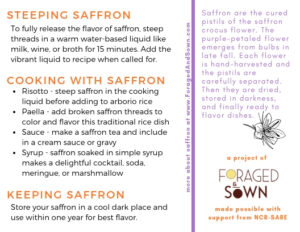
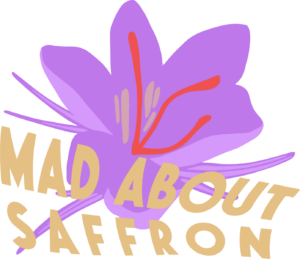
In October 2019, we created a second recipe card for saffron rice, included in this report as a product. 150 copies of the recipe were distributed to customers and Clintonville Farmers' Market shoppers as they sampled saffron rice during a farmers' market demo on October 19, 2019. Approximately 50 people attended the market demo.
In November 2019, we created and distributed 100 copies of the Saffron Growing Guide, included in this report as a product.
28 participants attended the field day on November 3, 2019 and completed our pre and post survey. 96% of participants reported an increase in their knowledge of growing saffron, 93% increased knowledge of processing saffron, and 61% reported an increase in their knowledge of SARE.
Also in November 2019, we released two Youtube videos, linked as products in this report. As of this writing, the Growing Saffron In The Midwest video has 165 views and the Saffron Harvesting and Processing video has 102 views.
On February 15, 2020, we offered a workshop 'Mad About Saffron: Growing and Cooking with A High-Value Midwest Spice' at the Ohio Ecological Food and Farm Association annual conference. 63 people attended the 90 minute session which included 3 samples, watching the youtube videos, and distribution of print growing guides. The presentation included discussion of production practices and an enterprise budget. Of the 54 people who returned post-session surveys, 80% reported they 'strongly agree' that 'presenters were knowledgable about the subject'. Many commented favorably overall, and one farmer wrote "I'm commiting space to saffron in our farm now!"
Throughout the project, we shared updates about Mad About Saffron through the website ForagedandSown.com/Saffron and Foraged & Sown Instagram. The recipe card and growing guides are linked there and future outreach efforts will be posted on the Foraged & Sown website and social media accounts.
Learning Outcomes
In Year One, we learned through experiencing one growing season in Ohio with both in-ground and hoop house production. Hoop house production was more prolific and the harvest was easier in year one. Ohio's 2018 autumn was wet and cool, yielding little outdoor production and making weed suppression difficult.
Our most valuable education came from visiting True Saffron farm in Ontario Canada in November 2018. There, we talked with experienced farmers about how they grow, harvest, and process their product. We spent a morning harvesting with them on site. Additionally we visited some of their value-added processors and retailers.
True Saffron Farm showed us that collaborating with small value-added producers is an effective strategy for marketing and sales. They provided us with critical information about harvesting and drying techniques that increases the quality of the final product. Their mentorship will be invaluable for our 2019 growing and outreach plans.
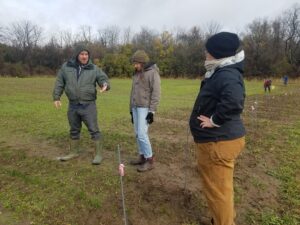

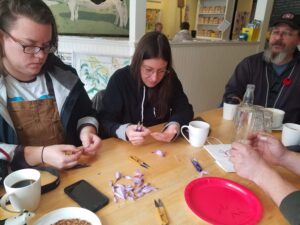
In Year Two of the project, we learned more from our own experience and the National Center for Saffron Research and Development. We completed outreach activities and more seriously marketed the finished saffron.
The 2019 field harvest of corms was difficult and disappointing. A wet fall and spring made controlling weeds very difficult, and some corms showed signs of damage by pests. Some farms, like our mentors True Saffron, bury saffron deeper in the soil and use mechanical cultivation; the clay-rich soils on our growing site make this impossible.
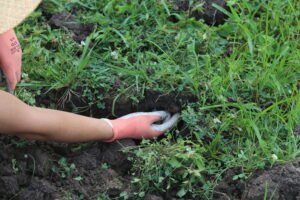
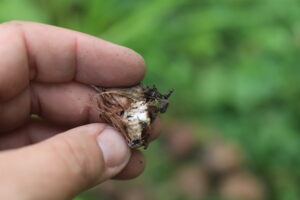
Therefore, we chose to transition to entirely container grown saffron. The containers are easier to manage for weeds and pests, making harvesting more convenient, and can be moved in the case of sub-optimal weather. Though pictured in a high tunnel, we also grew in containers on the group outdoors and these performed equally well to in the tunnel. If grown in a high tunnel, watering is essential, as is protection from deep freezes during the winter.
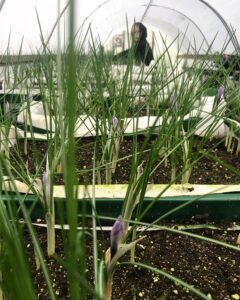
We sold all saffron direct to customers, for $4 per package of 15 cured saffron threads. To sell by weight, a farmer would need a very sensitive and expensive scale. In 2018, the only sales outlet was at farmers markets and holiday pop-up events. In 2019, the farm added wholesale accounts, online sales, and a year-round farmers market which created additional outlets.
Our simple but effective packaging design of a folded over card wrapping a sealed plastic sleeve is pictured below. Saffron needs a sealed, dark environment to preserve freshness and this does so while providing some space to educate the consumer about the product.
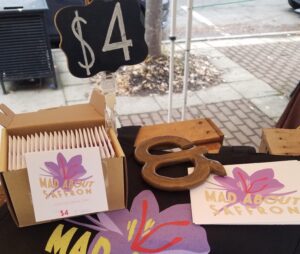
Customers in our experience were generally unfamiliar with saffron and did not know how to use it. We sampled saffron rice and handed out recipe cards and invitations to our field day at a farmers market demo. In these interactions, customers enjoyed the flavor and were engaged with questions but this positive interest did not necessarily convert to a rush of purchases. Purchases of saffron increased around the winter holidays, indicating that people included saffron in their gift giving and special meals.
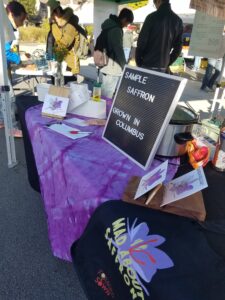
Attendees at our field day and conference presentation were similiarly very engaged and appreciative of our efforts to explore and educate about saffron. Despite our truthful sharing that the enterprise requires significant initial investment and customer demand isn't currently strong, many farmers and homesteaders showed interest in growing saffron.
In conclusion, the Mad About Saffron project taught us much about the production and marketing of saffron. It will remain among Foraged & Sown's offerings as a unique, flavor-packed product. There is much yet to explore about harvesting corms, finding efficiencies in curing and packaging, and creating a market for Midwestern-grown saffron.
Project Outcomes
We are very grateful for your support of small, unique projects like Mad About Saffron.
